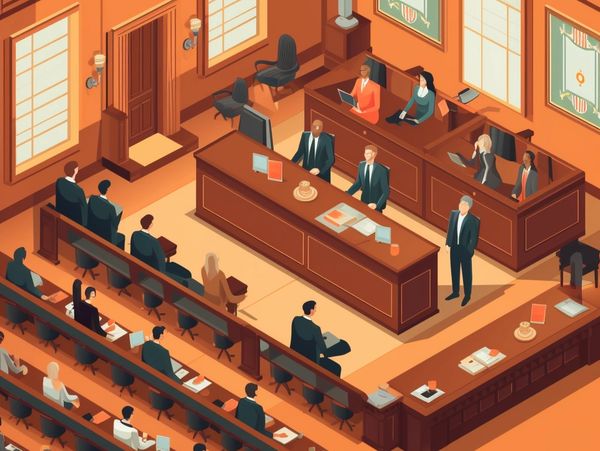Grasping the Art of Trial Presentations: Key Methods for Reliable Legal Arguments
Grasping the Art of Trial Presentations: Key Methods for Reliable Legal Arguments
Blog Article
Browsing the Complexities of Test Presentations: Tips for Seamless Shipment and Engaging Disagreements
In the realm of legal proceedings, the art of trial presentation stands as an important component of success. The intricacies inherent in trial presentations require a delicate balance of skill, method, and ability.

Comprehending Test Purposes
To effectively navigate a trial, it is vital to have a clear understanding of the purposes that require to be achieved. Before stepping into the court, lawful groups need to specify their objectives and wanted outcomes. These objectives work as directing principles throughout the trial, shaping methods and affecting decision-making procedures.
Comprehending test goals includes a detailed evaluation of the situation, lawful criteria, and the client's benefits. Trial Presentations. It needs a careful assessment of the truths, determining essential problems, and anticipating potential challenges. By establishing details and quantifiable goals, attorneys can tailor their debates and discussions to straighten with the wanted outcomes
Furthermore, a clear grasp of trial purposes allows legal teams to focus on proof, witnesses, and legal debates properly. It permits the advancement of a coherent story that resonates with the discretionary, enhancing the overall instance discussion.

Organizing Evidence Efficiently
Having a clear understanding of trial purposes lays the foundation for arranging evidence effectively in lawful proceedings. By straightening the presentation of proof with the desired outcomes of the test, legal teams can reinforce their disagreements and boost their persuasiveness.
One more crucial element in arranging evidence properly is establishing a sensible flow. Providing proof in a sequential and meaningful fashion can help develop an engaging narrative that sustains the lawful arguments being made. In addition, using visual help such as timelines, graphes, or graphs can further improve the company of proof and aid in clarifying complicated partnerships or sequences of events.
Moreover, making certain that all evidence provided is acceptable and pertinent to the situation is necessary. Inadmissible or unimportant evidence can diminish the toughness of the debate and possibly harm the reliability of the here and now event. A precise review and selection process should be undertaken to include just the most legitimately audio and impactful proof in the trial presentation.
Crafting Persuasive Narratives
Crafting compelling stories plays a crucial role in presenting influential debates throughout lawful proceedings. When building a narrative for a test presentation, it is important to develop a clear storyline that highlights vital factors and links them in a systematic way. By weaving together evidence, statement, and lawful arguments right into a natural and persuasive narrative, lawful professionals can successfully advocate for their customers and enhance the chance of a beneficial end result in the courtroom.
Understanding Aesthetic Aids
Efficient use visual aids is key to boosting the effect and quality of test presentations. Visual help, when click for more made use of strategically, have the power to simplify intricate details, reinforce bottom lines, and leave a long-term impression on the judge and jury. To understand aesthetic help in test presentations, it is important to make certain that they are clear, succinct, and relevant to the arguments being made.
When integrating visual help, such as graphes, timelines, charts, or photographs, into a trial presentation, it click for more is vital to keep them visually appealing yet expert. The visuals ought to match the verbal disagreements, offering a graph of the information being talked about without overwhelming the audience with unnecessary information.
In addition, exercising with the aesthetic help in advance is necessary to make certain a smooth shipment during the trial. Acquainting oneself with the web content, changes, and timings of each aesthetic aid can help keep the circulation of the discussion and avoid technical problems that might develop.
Providing Impactful Closing Arguments
An engaging closing argument serves as the culmination of a trial discussion, encapsulating the core story and persuading the judge and court towards a desirable decision. Begin by detailing the main disagreements that sustain your client's setting, stressing why the evidence provided throughout the test supports your narrative.
Additionally, integrating psychological appeal can better strengthen your closing debate. Inevitably, a well-crafted closing debate must leave why not try this out a long-term impact, engaging the court and court to rule in your customer's support.
Verdict
Finally, understanding test discussions entails recognizing goals, arranging evidence, crafting narratives, utilizing visual aids, and supplying impactful closing debates. By applying these approaches properly, legal representatives can offer their situation effortlessly and make compelling arguments in the courtroom. It is crucial to browse the intricacies of trial presentations with precision and ability to accomplish success in legal proceedings.
By straightening the discussion of evidence with the desired end results of the test, legal groups can reinforce their disagreements and enhance their persuasiveness (Trial Presentations). To understand aesthetic aids in test discussions, it is important to ensure that they are clear, succinct, and appropriate to the arguments being made
An engaging closing disagreement serves as the end result of a trial presentation, enveloping the core narrative and encouraging the judge and jury in the direction of a beneficial choice. Begin by detailing the main debates that support your customer's position, stressing why the evidence offered throughout the trial sustains your narrative.In verdict, grasping test presentations entails comprehending purposes, organizing proof, crafting narratives, making use of visual help, and delivering impactful closing disagreements.
Report this page